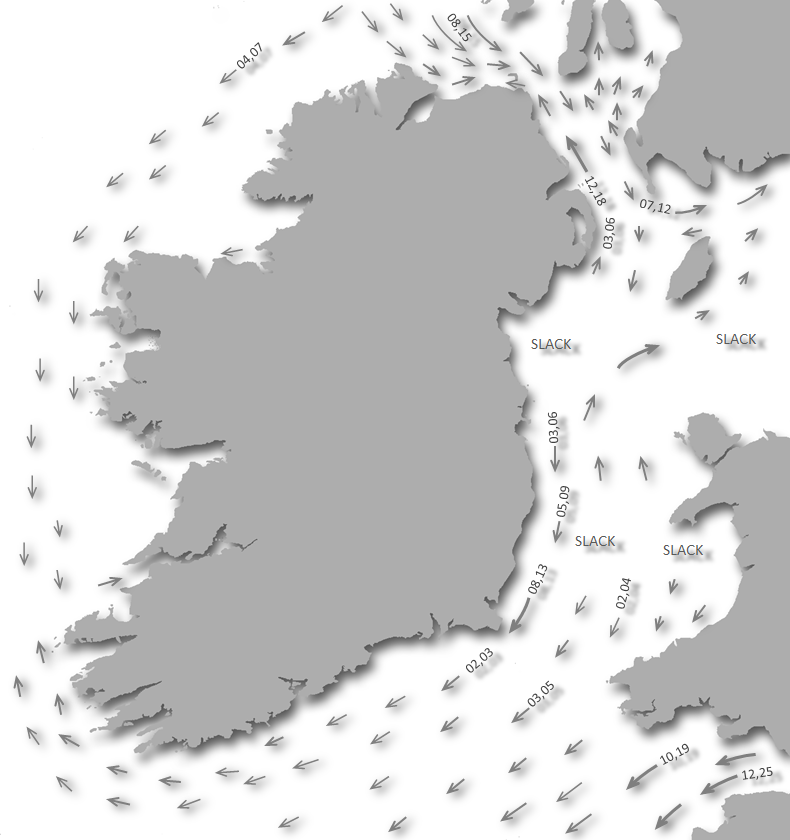
Ross Bay is an exposed location offering protection from all winds except those with a westerly component to which it is entirely open. Attentive navigation is required for access as, although there are no off-lying obstacles, there are no marks and the inlet is fringed by a rocky shoreline. Hence a stranger should only approach the bay in settled or offshore conditions with the benefit of good visibility.
Keyfacts for Ross Bay
Facilities
None listedNature





Considerations
Protected sectors
Approaches


Shelter


Last modified
July 19th 2018 Summary
An exposed location with attentive navigation required for access.Facilities
None listedNature





Considerations
Position and approaches
Expand to new tab or fullscreen
Haven position
 52° 35.180' N, 009° 52.520' W
52° 35.180' N, 009° 52.520' WThis is the middle of the bay in about 3.5 metres.
What is the initial fix?
The following Ross Bay initial fix will set up a final approach:
 52° 35.156' N, 009° 54.080' W
52° 35.156' N, 009° 54.080' W What are the key points of the approach?
Offshore details are available in western Ireland’s Coastal Overview for Loop Head to Slyne Head  .
.
 .
. Not what you need?
Click the 'Next' and 'Previous' buttons to progress through neighbouring havens in a coastal 'clockwise' or 'anti-clockwise' sequence. Below are the ten nearest havens to Ross Bay for your convenience.
Ten nearest havens by straight line charted distance and bearing:
- Kilbaha Bay - 1.2 nautical miles SSE
- Carrigaholt Bay - 6.5 nautical miles E
- Kilkee - 10 nautical miles NE
- Hog Island - 14 nautical miles E
- Kilrush - 14.2 nautical miles ENE
- Doonbeg - 15.4 nautical miles NE
- Illauntannig - 16.3 nautical miles SSW
- Barrow Harbour - 17.4 nautical miles S
- Scraggane Bay - 17.6 nautical miles SSW
- Fenit Harbour - 19 nautical miles S
These havens are ordered by straight line charted distance and bearing, and can be reordered by compass direction or coastal sequence:
- Kilbaha Bay - 1.2 miles SSE
- Carrigaholt Bay - 6.5 miles E
- Kilkee - 10 miles NE
- Hog Island - 14 miles E
- Kilrush - 14.2 miles ENE
- Doonbeg - 15.4 miles NE
- Illauntannig - 16.3 miles SSW
- Barrow Harbour - 17.4 miles S
- Scraggane Bay - 17.6 miles SSW
- Fenit Harbour - 19 miles S
Chart
How to get in?
Ross Bay is the northernmost of two small inlets that are situated between Ross Point and Fodry Point, and which are separated by the rocky promontory of Moneen Point. The 80 metres high Cahercroghaun Hill rises about a mile and a half northeast of Loop Head and, being about midway between the headland and the bay, provides a good landmark.
 The initial fix is set on the 20-metre contour one mile west of Ross Bay from which a course of due east leads into the centre of the bay. Ross Bay is entered between Ross Point and Moneen Point, situated 600 metres to the south. Rocks fringe both shores but extend out further from the southern shore. So stay slightly north of centre all the way in.
The initial fix is set on the 20-metre contour one mile west of Ross Bay from which a course of due east leads into the centre of the bay. Ross Bay is entered between Ross Point and Moneen Point, situated 600 metres to the south. Rocks fringe both shores but extend out further from the southern shore. So stay slightly north of centre all the way in.  Anchor in the middle of the horseshoe-shaped head of the bay in 2 to 3 metres. The bottom of the bay is of rock with large patches of sand that will be clearly visible in the translucent waters. A beach landing is available at the head of the bay. The shoreline between Ross Point and Fodry Point is characterised by shingle banks, which have been formed by deposited eroded rock and then moulded here.
Anchor in the middle of the horseshoe-shaped head of the bay in 2 to 3 metres. The bottom of the bay is of rock with large patches of sand that will be clearly visible in the translucent waters. A beach landing is available at the head of the bay. The shoreline between Ross Point and Fodry Point is characterised by shingle banks, which have been formed by deposited eroded rock and then moulded here.Why visit here?
Ross Bay is a local fishing boat hide whilst waiting for a turn of the weather. Likewise, it makes for an ideal location for leisure vessels to take shelter from strong easterlies. For vessels planning to enter the Shannon from the north, it provides a good wait location in the event of an unfavourable wind or tide. Furthermore, it is very much a straight in and out haven, providing a very convenient offshore wind lunch stop for vessels making passage along this coast.Although tactically useful from a sailing perspective Ross Bay also has its own charms. Those who find themselves making use of the haven will have plenty of reason to set down a shore party to enjoy the immediate surroundings, as the views and scenery around this area are breathtakingly beautiful.
 Bridges of Ross
Bridges of RossImage: Mark Murray CC BY-SA 2.0
What should not be missed here is the unique phenomenon of the Bridges of Ross on the north side of Ross Point. Historically the Bridges of Ross referred to a trio of spectacular natural sea arches, two of which have since fallen into the sea. While only one ‘bridge’ remains the name remains in the plural. The bridge covers the fingers of rock that stretch out from the coast and are narrow strips of land between collapsed cave roofs. They were created by erosive wave action creating a number of blowholes that slowly break down the cliffs.
A few miles northeast of Ross Point is a particularly notable example of a blowhole, were with a big onshore seaway the seas are expelled from a Puffing Hole carrying spray up a considerable height.
 Loop Head Lighthouse
Loop Head LighthouseImage: Tourism Ireland
Although rugged and remote, Ross Bay is tame compared to the mile and a half of sheer cliffs that lead from it to Loop Head. The Loop Head peninsula is one of Ireland’s most wildly beautiful locations and a best-kept secret. The road running past the head of the bay leads to the parking lot in front of the Loop Head lighthouse compound. Although the lighthouse’s grounds may be closed to the public there is a coastal path here that is available to all its visitors. It is a very easy flat walk that follows the edge of the peninsula just feet from the edge all the way. About 2 km long, each step of the path offers spectacular vistas over steep precipices and ocean with the sound of the sea crashing into the cliffs below. Moreover, you are most likely to have it all to yourself.
This is a completely different experience to the area’s more famous Cliffs of Moher. Although spectacular, the Cliffs of Moher can get overwhelmed with busloads of tourists and the cliffs there are so restricted that it is very difficult to get close to the edge these days. This is very different to the experience available at Loop Head.
What facilities are available?
There is nothing at this remote location except for the road that runs past the head of the bay and a few scattered houses nearby.Any security concerns?
Never an issue known to have occurred to a vessel anchored in this secluded bay.With thanks to:
Anthony Lucey, Area Officer, Irish Coast Guard Kilkee.Aerial views of the Bridges of Ross
Add your review or comment:
Please log in to leave a review of this haven.
Please note eOceanic makes no guarantee of the validity of this information, we have not visited this haven and do not have first-hand experience to qualify the data. Although the contributors are vetted by peer review as practised authorities, they are in no way, whatsoever, responsible for the accuracy of their contributions. It is essential that you thoroughly check the accuracy and suitability for your vessel of any waypoints offered in any context plus the precision of your GPS. Any data provided on this page is entirely used at your own risk and you must read our legal page if you view data on this site. Free to use sea charts courtesy of Navionics.











 The head of Ross Bay
The head of Ross Bay
